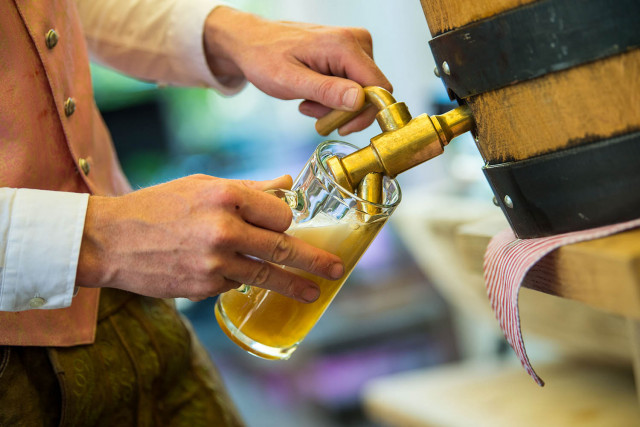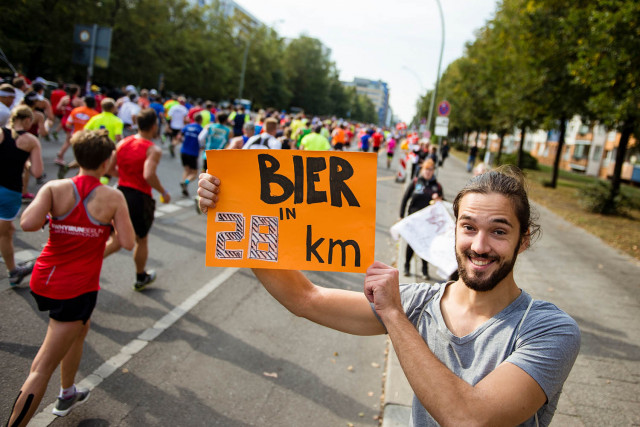The only thing more German than beer? Statistics about beer. The Federal Statistical Office of Germany has just released its annual beer statistics, tracking beer consumption, brewery openings and even the amount of beer paid out to brewery staff.
The stats shed light on changing trends and consumption habits of Germany's favourite tipple.
As we wrote back in 2017, Germans have been gradually consuming less and less of the amber fluid. From 150 litres per person per year in the 1970s, this amount is now under 100.
This has been facilitated by a number of different factors including health concerns and the changing cultural status of beer.
The statistics also showcased some good news for beer lovers, with new breweries opening up year after year all over the country. This has led to an increase in the variety of beer, with more creative ‘craft beer’ styles being produced.
With the help of a couple of experts in their field, we broke down the statistics and looked at what they meant for the future of beer in Germany.
Bad news beers?
Beer consumption in Germany has been on the decline for decades. 2018 represented the first time beer sales have increased since 2014 – although the World Cup and the scorching hot summer may have something to do with that.
Beer sales have been in decline in Germany every year since record-keeping began in 1993. In 1994 Germans downed a massive 108 million hectolitres of beer, working out to roughly 133 litres of beer per person per year.
Since that time, beer sales have only increased twice up until 2018 – in 2006 when Germany hosted the world cup (0.7 percent increase) and in 2014 when Germany won it (0.4 percent increase).
SEE ALSO: Why Germans are losing their taste for beer
Germany’s 2018 beer consumption was 78 million hectolitres, which works out as roughly 93 litres per person.
While the statistics only go back to 1993, beer consumption has been on the decline since the 1970s. The average per capita consumption in 1976 was 151 litres per person.
p.p1 {margin: 0.0px 0.0px 0.0px 0.0px; font: 12.0px Helvetica}
p.p1 {margin: 0.0px 0.0px 0.0px 0.0px; font: 12.0px Helvetica}
!function(){“use strict”;window.addEventListener(“message”,function(a){if(void 0!==a.data[“datawrapper-height”])for(var t in a.data[“datawrapper-height”]){var e=document.getElementById(“datawrapper-chart-“+t);e&&(e.style.height=a.data[“datawrapper-height”][t]+”px”)}})}();
It’s quittin’ time
Another major statistical trend might just be the most German thing ever – beer paid to brewery employees. Formerly, brewery employees each received a stipend in beer in addition to their wages for their work.
While this varied depending on the company, it was a considerable perk of working at a brewery. Plus, for many brewery workers, getting paid in beer simply cut out the middle man.
Over time, beer paid out to employees decreased. From a high of 375,000 litres in 1993, only 131,000 litres are paid out in the present day. For brewery employees, there is however a silver lining – with beer paid out to employees increasing by 2,500 litres from 2017 to 2018.
The rumours of the death of German thirst have been greatly exaggerated
While the beer consumption of modern Germans may have declined, it still ranks as one of the highest in the world. After the Czechs and the Austrians, Germany has the highest average beer consumption.
The Germany-wide consumption differs significantly however, with beer a much bigger part of life in Bavaria than in other states. In fact, if Bavaria was to become a separate country, it would have the world’s highest beer consumption – which might be the best argument for Bavarian separatism we’ve ever heard.
Marc-Oliver Huhnholz of the German Brewers Association says that whatever has been lost in total consumption has been more than made up for in variety – and that Germany’s love for beer remains strong.
“The German beer market is unparalleled in size and variety. Every week, at least one new beer comes on the market,” he said.
“German beer drinkers could theoretically try a different beer every day for more than 15 years – and would not have to taste it twice.
“The volume of drinking has fallen from an internationally very high level to a still high level.”
Germany’s beer renaissance: The rise of micro brewing and ‘craft beer’
Another recent trend which has continued is the move away from mass-produced beer to so-called ‘craft beers’.
Craft beer production was slower to catch on in Germany than in other countries – due primarily to the existing quality of the German drop – but in recent years smaller breweries have opened up all over the country.
The figures showed that Germany added 39 new breweries from 2017 to 2018, continuing a trend which has seen brewery numbers increase every year since 2006. In the ten years to 2019, 206 new breweries have opened up across the country.

More and more smaller breweries open up around Germany each year. Image: DPA
“We have been experiencing a renaissance of beer and brewing in Germany for some years now,” Huhnholz said.
“This was certainly also inspired by the craft beer wave. This trend has been recognized by many enthusiasts who believe they can conquer the market with their own beers.”
Ben Owens, a brewer at Berlin’s Hops and Barley microbrewery, says that larger brewers are being hit by decreased consumption.
“The decrease is definitely concerning for the big industrial brewers. 90 percent of beer sold in Germany is from industrial brewers, and that’s where the decrease is coming from – the mass-produced beers,” Owens said.
“People have different attitudes to microbreweries. They are actually on the rise so they will not be affected by this.
“People are more interested in handcrafted products and they have realised that you can pay a bit more for something better.”
Health concerns fuelling the decrease
A major factor in the shifting trends is a changing attitude to alcohol and health.
Beer is increasingly seen as unhealthy, which has moved German drinkers on to other alcoholic beverages like wine – or off the booze completely.
Alcohol free (alkoholfrei) beer sales have skyrocketed in Germany in recent years, with German consumers now having over 400 different options. In Germany, every 20th bottle of beer brewed is alcohol free.
Owens says health is the prominent factor underpinning the shifting trends.
“I think it comes down to health reasons and societal changes. Germany had this culture – a working beer culture – it was very regular for beer to be a part of your everyday life and your working day. Nowadays it is far less common for people to drink while they work,” he said.

A man holds a sign of encouragement at the Berlin marathon. Image: DPA
Owens says the changes can be seen in different generational attitudes to drinking in the brewing industry.
“Younger people in the industry have a different attitude to beer and drinking. In the 1970s brewers would start their shift with a beer,” Owens said.
“Some of the older brewers might still do that, but the younger brewers consider the health benefits of not drinking beer as part of their daily working life.”
Changing culture and ‘status’ of beer drinking
Another major reason for the trend is the changing cultural status of beer.
Walter König of the Bavarian Brewers' Association explained to The Local in 2017 that in the 1970s, beer used to have a higher cultural and status value – along with a higher cost.
Now that beer is cheaper and more readily available, this status has been somewhat eroded.
Other factors like immigration from non-drinking regions of the world to increases in car usage – along with stagnant population growth statistics – have all played a role in the decrease in consumption.
Change afoot at the world's largest beer festival?
Changes are sweeping through the German beer scene. But what about the world’s beer mecca – the Munich Oktoberfest?
The Munich Oktoberfest is served by the six major Munich brewers who are permitted to have tents on the fairgrounds. With these big brewers more and more willing to experiment, could a change be coming at the world’s largest beer festival?
“It would feel weird to have a one litre IPA (at the Oktoberfest) – you would want a real easy to drink lager,” Owens said.
“Bavarians are so proud, but it wouldn’t surprise me if there’s a pale ale on tap sometime soon.”
p.p1 {margin: 0.0px 0.0px 0.0px 0.0px; font: 12.0px Helvetica}
p.p2 {margin: 0.0px 0.0px 0.0px 0.0px; font: 12.0px Helvetica; min-height: 14.0px}



 Please whitelist us to continue reading.
Please whitelist us to continue reading.
Member comments